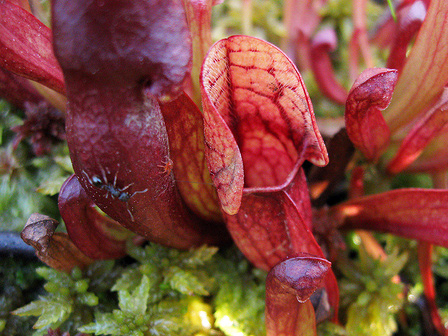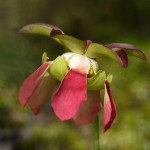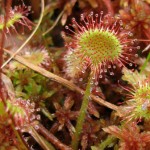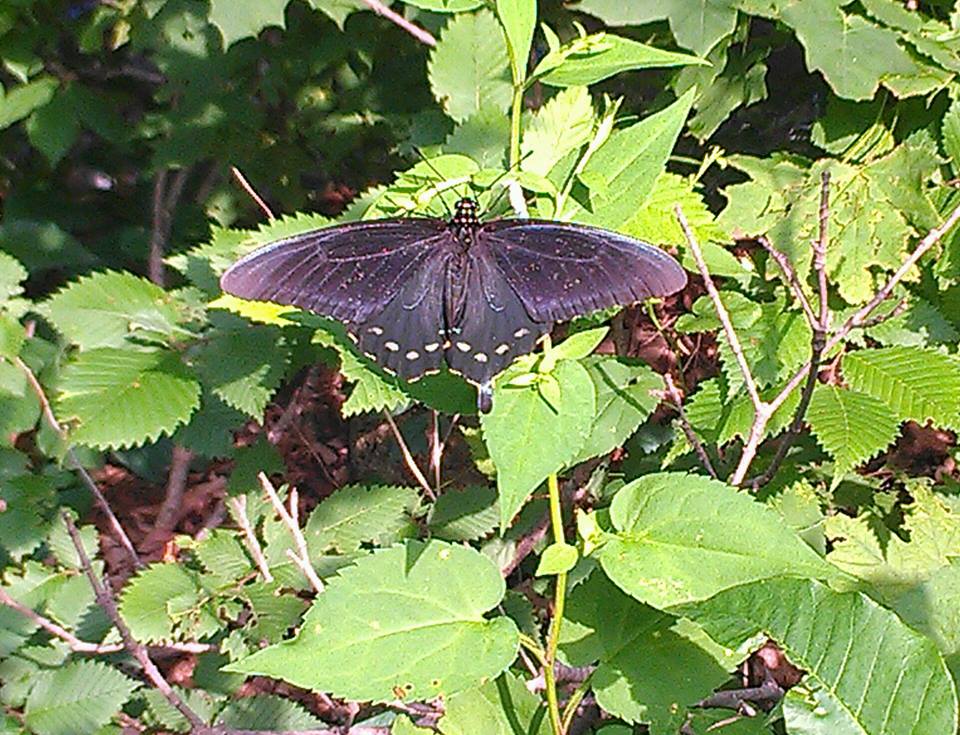 Carnivorous plants may seem like the stuff of science fiction. But these fascinating plants exist. Better yet, you can find them here in Massachusetts.
Carnivorous plants may seem like the stuff of science fiction. But these fascinating plants exist. Better yet, you can find them here in Massachusetts.
And now’s the time to go looking for them: they’re trapping this summer’s crop of insects and other small invertebrates, and many are blooming.
What is a Carnivorous Plant?
Unlike most plants that absorb vital nutrients directly from the soil, carnivorous plants grow in habitats like bogs that are low in nitrogen and other substances needed for growth. They survive by trapping and eating nutritious animals such as insects and small crustaceans.
Types of Carnivorous Plants
There are three types of insect-eating plants that you can find in Massachusetts.
Pitcher Plant
 Look for the purple pitcher plant (Sarracenia purpurea) amongst sphagnum mosses in a bog or other acidic wetland. During spring and summer, it produces a 2-inch-wide green and red flower that looks like a hovering UFO. Its vase-shaped leaves are 4-10 inches long. Peer inside one of these leaves and you’ll see a bacteria-laden soup. Insects fall into this fluid and are digested; they can’t escape because the walls are lined with downward-pointing hairs.
Look for the purple pitcher plant (Sarracenia purpurea) amongst sphagnum mosses in a bog or other acidic wetland. During spring and summer, it produces a 2-inch-wide green and red flower that looks like a hovering UFO. Its vase-shaped leaves are 4-10 inches long. Peer inside one of these leaves and you’ll see a bacteria-laden soup. Insects fall into this fluid and are digested; they can’t escape because the walls are lined with downward-pointing hairs.
Sundew
 There are 3 species of sundew in Massachusetts, and their names describe their shapes: the round-leaved sundew (Drosera rotundifolia), the spatulate-leaved sundew (Drosera intermedia), and the thread-leaved sundew (Drosera filiformis). You may find them clinging to a boardwalk or nestled in bog greenery. The purple to white 5-petaled flowers appear in mid- to late-summer. The leaves are covered in long reddish hairs, each of which bears a sugary, sticky droplet of “dew”. This fluid traps insects, and then the leaves wrap around them and consume them.
There are 3 species of sundew in Massachusetts, and their names describe their shapes: the round-leaved sundew (Drosera rotundifolia), the spatulate-leaved sundew (Drosera intermedia), and the thread-leaved sundew (Drosera filiformis). You may find them clinging to a boardwalk or nestled in bog greenery. The purple to white 5-petaled flowers appear in mid- to late-summer. The leaves are covered in long reddish hairs, each of which bears a sugary, sticky droplet of “dew”. This fluid traps insects, and then the leaves wrap around them and consume them.
Bladderwort
 There are 13 species of bladderwort found across our state. Their snapdragon-like yellow or purple flowers rise singly or in little clusters above the water. These are supported below the surface by root-like structures that bear many small hairy bladders. When a small creature like a mosquito larva touches one of the hairs, this contact triggers a change in the shape of the bladder, which vacuums up the prey for digestion.
There are 13 species of bladderwort found across our state. Their snapdragon-like yellow or purple flowers rise singly or in little clusters above the water. These are supported below the surface by root-like structures that bear many small hairy bladders. When a small creature like a mosquito larva touches one of the hairs, this contact triggers a change in the shape of the bladder, which vacuums up the prey for digestion.
Where to See Them
All three types of carnivorous plants can be seen in freshwater, nutrient-poor wetlands across the state, and you’ll find them at many of our wildlife sanctuaries, such as Broadmoor in Natick, High Ledges in Shelburne, Skunknett River in Barnstable, and Oak Knoll in Attleboro. Or, join a naturalist from the Blue Hills Trailside Museum in Milton for a Family Bog Walk on July 28 for a chance to see one.
Have you seen any carnivorous plants? If so, tell us where and when in the comments!
 When Lisa Daley-Bromberg sent us this photo she took in Uxbridge, Massachusetts asking for an identification, we got very excited.
When Lisa Daley-Bromberg sent us this photo she took in Uxbridge, Massachusetts asking for an identification, we got very excited.

 Carnivorous plants may seem like the stuff of science fiction. But these fascinating plants exist. Better yet, you can find them here in Massachusetts.
Carnivorous plants may seem like the stuff of science fiction. But these fascinating plants exist. Better yet, you can find them here in Massachusetts. Look for the purple pitcher plant (Sarracenia purpurea) amongst sphagnum mosses in a bog or other acidic wetland. During spring and summer, it produces a 2-inch-wide green and red flower that looks like a hovering UFO. Its vase-shaped leaves are 4-10 inches long. Peer inside one of these leaves and you’ll see a bacteria-laden soup. Insects fall into this fluid and are digested; they can’t escape because the walls are lined with downward-pointing hairs.
Look for the purple pitcher plant (Sarracenia purpurea) amongst sphagnum mosses in a bog or other acidic wetland. During spring and summer, it produces a 2-inch-wide green and red flower that looks like a hovering UFO. Its vase-shaped leaves are 4-10 inches long. Peer inside one of these leaves and you’ll see a bacteria-laden soup. Insects fall into this fluid and are digested; they can’t escape because the walls are lined with downward-pointing hairs. There are 3 species of sundew in Massachusetts, and their names describe their shapes: the round-leaved sundew (Drosera rotundifolia), the spatulate-leaved sundew (Drosera intermedia), and the thread-leaved sundew (Drosera filiformis). You may find them clinging to a boardwalk or nestled in bog greenery. The purple to white 5-petaled flowers appear in mid- to late-summer. The leaves are covered in long reddish hairs, each of which bears a sugary, sticky droplet of “dew”. This fluid traps insects, and then the leaves wrap around them and consume them.
There are 3 species of sundew in Massachusetts, and their names describe their shapes: the round-leaved sundew (Drosera rotundifolia), the spatulate-leaved sundew (Drosera intermedia), and the thread-leaved sundew (Drosera filiformis). You may find them clinging to a boardwalk or nestled in bog greenery. The purple to white 5-petaled flowers appear in mid- to late-summer. The leaves are covered in long reddish hairs, each of which bears a sugary, sticky droplet of “dew”. This fluid traps insects, and then the leaves wrap around them and consume them.